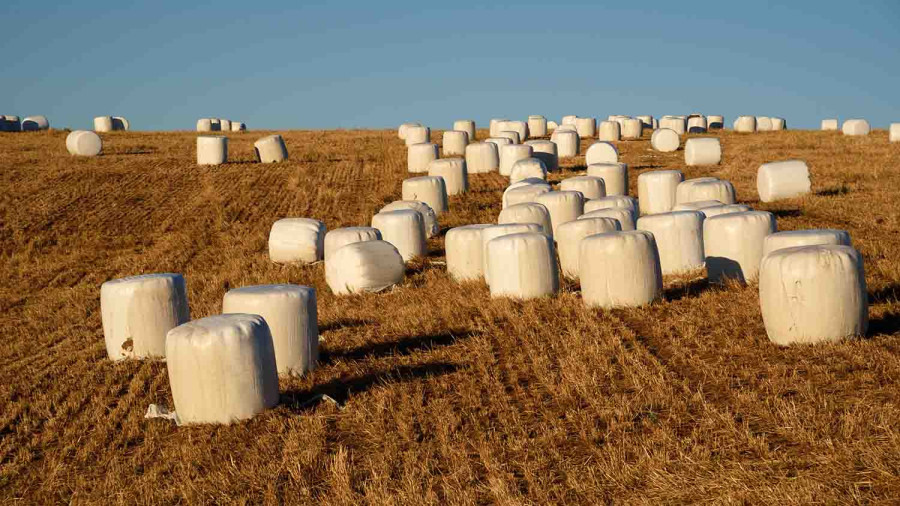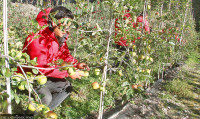National
What’s this humble grass that made it to high-level Nepal-China talks
Haylage is greatly sought after as animal food on the other side of the Himalaya.
Krishana Prasain
Grass was high on the agenda of the high-level talks held between Nepal and China on Saturday, which concluded with the signing of varied agreements ranging from a Rs11 billion aid package to cross-border railway and transmission lines.
One of the nine documents signed by Nepali and Chinese officials in the presence of the two foreign ministers Narayan Khadka and Wang Yi is entitled “Protocol on the safety and health conditions of haylage export from Nepal to China”.
Haylage, or grass chopped and packed, is greatly sought after as animal fodder in the highlands on the other side of the Himalaya.
Experts say that Nepal is in a favourable position to benefit by exporting haylage because, well, the grass is greener on this side, so to speak.
According to former agriculture secretary Hari Dahal, haylage has high nutrient value and helps to boost milk production.
The fodder is in high demand in the Tibetan plateau which lies at an average altitude of 4,000 metres above sea level to feed cattle, mainly yaks.
In Tibet, the growing season of forage is very short and lasts from May to August. The harvesting time is during the rainy season which results in feed shortages, according to experts.
How is haylage prepared?
Experts say grass is cut at the pre-bloom stage, chaffed into lengths of 1-2 inches and allowed to wither for 2-3 hours. Then 4-5 percent molasses plus 0.1 percent urea is added to the chaffed grass and thoroughly mixed.
The mixture is then tightly packed in polythene bags. Haylage becomes ready within 60-90 days. This method preserves the grass with all the nutrients.
"Haylage can also be made from maize plants and other green grasses," said Chandra Dhakal, senior livestock development officer at the Department of Livestock Services.

Nepal has the potential to produce haylage for export to Tibet to feed yaks, mountain goats and horses.
"A few Chinese companies have invested in ventures in Chitwan to produce grass," said Dhakal. “They have been seeking approval from the Nepal government to export haylage to Tibet. This agreement, we believe, will facilitate the export of haylage."
The pact has also opened the way for Nepali traders to export haylage, apart from the traditional handicraft that Nepalis have been exporting to China for decades.
Few people know about haylage and its economic potential, and it’s not in the list of Nepal’s exportable products. “We are not aware of this commodity till now,” said Posh Raj Pandey, a trade economist. “We don’t think it’s important.”
But some experts say haylage can be a potential exportable product to substitute traditional products which Nepal has been exporting to China for decades, and help to narrow the trade deficit which has been steadily growing.
According to the Department of Customs, imports from China in fiscal 2020-21 rose 28.58 percent year-on-year to Rs233.92 billion.
Before Covid-19, in fiscal 2018-19, imports amounted to Rs205.51 billion. In fiscal 2017-18, imports were valued at Rs159.98 billion, up from Rs129.87 billion in fiscal 2016-17.
Nepal suffers a huge deficit in its trade with China, importing more than 200 times the amount of exports.
In 2020-21, Nepal imported Rs233.92 billion worth of goods from the northern neighbour while its exports across the Himalaya were valued at a mere Rs1 billion. This translates into a trade deficit of Rs232.90 billion, which accounted for 14 percent of Nepal’s total trade deficit in fiscal 2020-21.
“Obviously, haylage has potential. But we need to work a lot in terms of health and safety protocol, the obvious requirement for international trade,” said Prakash Kumar Sanjel, spokesperson for the Ministry of Agriculture and Livestock Development.
“First, grass production needs to increase on a larger scale. Then laboratory services need to be strengthened. Dealing with health and safety protocols is challenging. There have been no studies on haylage till now," said Sanjel.
"Five years ago, Nepal signed an agreement with China to export sweet orange by following safety and health protocols, but till now the country has not been able to export it," he said.
The Chinese side has said that sweet orange must be pest-free; but for Nepal it is a challenging task.
In 2002, the European Union banned the import of Nepali honey stating that its quality was not as per the European standard. Issues regarding the export of Nepali ginger and tea have persisted for a long time due to sanitary and phytosanitary (SPS) measures.
The SPS are quarantine and biosecurity measures which are applied to protect human, animal or plant life or health from risks arising from toxins and contaminants in food and feed.
“Production might not be a big deal, but fulfilling the export protocols is not easy for a country like Nepal,” said Sanjel.
There has been sporadic production of haylage in Nepal. Commercial production has not started because the use of haylage is minimal in the country. “Commercial production has not thrived for lack of market assurance,” said Sanjel.
But hopes are up. “We believe that with the export agreement, production too will increase in a massive way,” said Sanjel.
Haylage, currently, is being produced in a few districts like Chitwan, Nawalparasi, Gorkha and Dang by farmer groups. “But there is no specific data regarding the acreage,” Sanjel said.
“The agreement was moved forward considering potential demand in China and Nepal's ability to produce it."
According to Dahal, haylage can be produced in the hills and Tarai plains.
In the Tarai, farmers mostly use paddy straw for food which they store by making a conical pile, and feed it to their animals during the season when green grass is not available.
“Haylage sales in the domestic market are small. If its export potential can be exploited, it will support a large number of farmers whose income mostly depends on seasonal crops,” Dahal said.




 6.73°C Kathmandu
6.73°C Kathmandu










%20(1).jpg&w=300&height=200)




